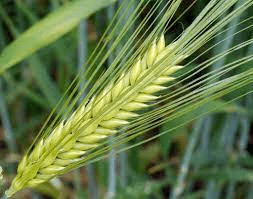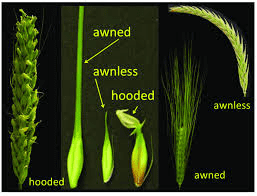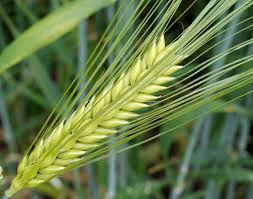Barley awns are bristle-like structures that extend from the tips of the spikelets, the flower clusters of the barley plant. They are slender, hair-like appendages that vary in length and can be straight or curved. Awns are characteristic of certain barley varieties and are often used as a distinguishing feature in plant taxonomy.
Economically, barley awns have several implications for barley cultivation and management. While they do not directly contribute to grain yield, they can affect harvesting, processing, and animal feed quality. Barley awns can interfere with harvesting equipment, causing mechanical damage and reducing grain quality. Therefore, barley varieties with shorter or absent awns are often preferred for mechanized harvesting.
Additionally, barley awns can impact the palatability and digestibility of barley straw and hay when used as animal feed. Awns contain silica and other compounds that may make them less palatable to livestock or cause irritation in the digestive tract. Barley varieties with shorter awns or awnless traits may be preferred for animal feed to minimize these issues.
Furthermore, barley awns have been studied for their potential ecological and agronomic benefits. They may play a role in seed dispersal and protection against herbivory and pathogens. Some researchers have investigated the relationship between awn length and environmental adaptation, exploring how awns contribute to the barley plant’s resilience to stressors such as drought, heat, and pests.
The Economic Importance and Uses of Barley Awns

1. Seed Dispersal: Barley awns play a crucial role in seed dispersal. Their elongated structure aids in wind dispersal, allowing barley seeds to be carried over long distances, facilitating natural propagation and colonization of new areas.
2. Genetic Variation: Barley awns contribute to genetic variation within barley populations. Variations in awn length, color, and texture are subject to natural selection, influencing adaptation to different environmental conditions and pest pressures.
3. Agricultural Cultivation: Barley awns influence agricultural practices such as seed selection and crop management. Awn characteristics, such as length and orientation, affect seed drilling, soil coverage, and water absorption, impacting crop establishment and yield.
4. Erosion Control: Barley awns, when left as crop residues or incorporated into the soil after harvest, contribute to soil erosion control. Their presence helps stabilize soil structure, reduce water runoff, and prevent erosion, preserving soil fertility and productivity.
5. Animal Forage: Barley awns, along with other barley residues, are utilized in animal forage production. Barley straw, which includes awns, provides fiber and roughage in livestock diets, supporting digestion and nutrient utilization in ruminants.
6. Crafts and Decor: Dried barley awns are used in crafts and decor for their unique appearance and texture. They are incorporated into floral arrangements, wreaths, and seasonal decorations, adding visual interest and rustic charm to home decor items.
7. Biofuel Feedstock: Barley awns are potential feedstocks for biofuel production. Their cellulose and lignin content can be converted into biofuels such as ethanol and biogas through biochemical and thermochemical processes, contributing to renewable energy production.
8. Soil Amendment: Barley awns, when incorporated into the soil, contribute to soil organic matter content and nutrient cycling. Their decomposition enriches soil fertility, improves soil structure, and enhances microbial activity for healthy plant growth.
9. Biodegradable Packaging: Barley awns are explored as raw materials for biodegradable packaging products. Their natural biodegradability makes them suitable for use in environmentally friendly packaging solutions, reducing plastic waste and environmental pollution.
10. Wildlife Habitat: Barley awns residues provide habitat and food sources for wildlife in agricultural landscapes. They support insect populations, small mammals, and birds, contributing to biodiversity conservation and ecological balance.
Read Also: General Introduction to Pig Management
The Products and By-products That Can Be Derived From Barley Awns

1. Biodegradable Mulch Films: Barley awns residues can be processed into biodegradable mulch films used in agriculture. These films suppress weed growth, retain soil moisture, and degrade naturally over time, reducing plastic pollution in the environment.
2. Animal Bedding: Barley awns, along with other barley residues, are used as animal bedding material in livestock farming operations. Their absorbent properties provide comfort and hygiene for animals in barns and stables, improving welfare and productivity.
3. Bioplastics: Barley awns residues can be utilized in the production of bioplastics and packaging materials. Their natural biodegradability makes them attractive alternatives to conventional petroleum-based plastics, reducing environmental impact and plastic waste.
4. Compost: Barley awns residues are valuable additions to compost piles and bins. Their decomposition adds organic matter and nutrients to the compost, enriching the soil for plant growth and improving soil health in agricultural and horticultural applications.
5. Erosion Control Mats: Barley awns residues can be incorporated into erosion control mats used in land restoration projects. These mats stabilize soil, prevent erosion, and promote vegetation establishment in erosion-prone areas, supporting environmental conservation efforts.
6. Biofuel Feedstock: Barley awns residues are potential feedstocks for biofuel production. Their cellulose and lignin content can be converted into biofuels such as ethanol and biogas through biochemical and thermochemical processes, contributing to renewable energy production.
7. Papermaking: Barley awns fibers can be processed into pulp for papermaking. Their cellulose content provides strength and durability to paper products, offering a sustainable alternative to traditional wood-based paper production.
8. Soil Amendment: Barley awns residues, when incorporated into the soil, contribute to soil organic matter and nutrient content. Their decomposition enhances soil fertility, improves soil structure, and promotes healthy plant growth in agricultural systems.
9. Biogas Production: Barley awns residues can be anaerobically digested to produce biogas. Biogas production from agricultural residues helps reduce greenhouse gas emissions and dependence on fossil fuels for energy, contributing to climate change mitigation efforts.
10. Wildlife Habitat Enhancement: Barley awns residues provide habitat and food sources for wildlife in agricultural landscapes. They support insect populations, small mammals, and birds, contributing to biodiversity conservation and ecological balance.
Read Also: Sudangrass (Sorghum × drummondii) Complete Guide
Frequently Asked Questions (FAQ’s) About Barley Awns

1. Are barley awns important for seed dispersal?
Yes, barley awns play a crucial role in seed dispersal by aiding in wind dispersal, allowing barley seeds to be carried over long distances.
2. Can barley awns be used as animal bedding?
Yes, barley awns, along with other barley residues, are commonly used as animal bedding material in livestock farming operations due to their absorbent properties and availability as agricultural residues.
3. Do barley awns contribute to soil erosion control?
Yes, barley awns contribute to soil erosion control by stabilizing soil structure, reducing water runoff, and preventing erosion when left as crop residues or incorporated into the soil after harvest.
4. Can barley awns be composted?
Yes, barley awns are valuable additions to composting systems and contribute to the decomposition process, producing nutrient-rich compost for soil enrichment and plant growth.
5. Are barley awns utilized in biodegradable materials production?
Yes, barley awns can be processed into biodegradable materials such as mulch films and packaging products, offering environmentally friendly alternatives to conventional plastics.
6. Do barley awns influence agricultural cultivation practices?
Yes, barley awns influence seed drilling, germination, and crop establishment in agricultural cultivation, impacting crop yield and uniformity.
7. Can barley awns be used in biofuel production?
Yes, barley awns are potential feedstocks for biofuel production, contributing to renewable energy production and reducing dependence on fossil fuels for energy.
8. Are barley awns suitable for papermaking?
Yes, barley awns fibers can be processed into pulp for papermaking, providing a sustainable alternative to traditional wood-based paper production.
9. Do barley awns contribute to soil fertility?
Yes, barley awns contribute to soil fertility by adding organic matter and nutrients to the soil, improving soil structure and nutrient availability for plant growth.
10. Are barley awns important for wildlife habitat enhancement?
Yes, barley awns provide habitat and food sources for wildlife in agricultural landscapes, supporting biodiversity conservation and ecological balance.
